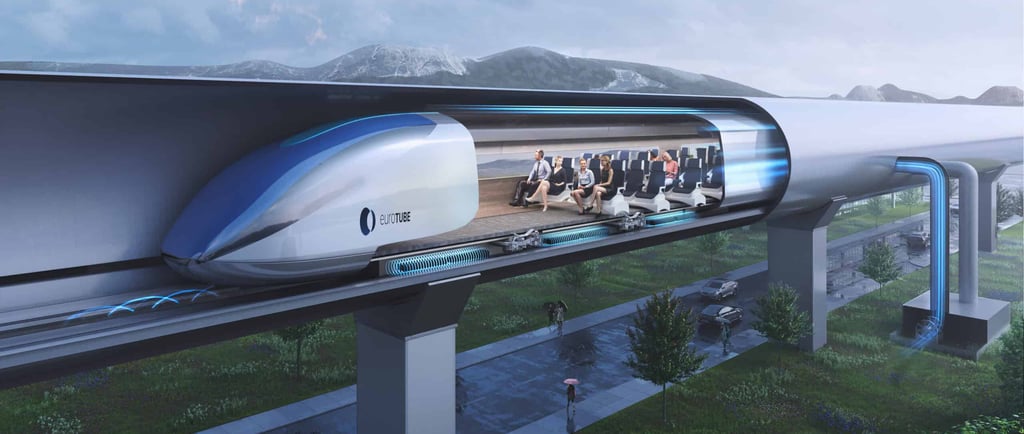Understanding Hyperloop: The Future of Transportation
4/15/20253 min read


What is Hyperloop?
The Hyperloop is a proposed high-speed transportation system in which passengers or cargo are transported in pods or capsules through a low-pressure tube. The idea behind the Hyperloop is to drastically reduce travel time between cities, making it possible to travel hundreds of kilometers in minutes — faster than current airplanes and more energy-efficient than trains or cars.
The concept was popularized by Elon Musk in a white paper published in 2013, although the basic idea has been around for decades. Since then, several companies and universities around the world have been working on making this idea a reality, including Virgin Hyperloop, Hyperloop Transportation Technologies (HTT), and Elon Musk's The Boring Company.
How Does It Work?
1. The Tube
Hyperloop operates in a sealed tube that runs either above ground on columns or underground. The tube is vacuum-sealed, meaning that most of the air is removed. This creates an ultra-low pressure environment that reduces air resistance — one of the major forces that slow down vehicles.
By reducing air drag, the pods can move at very high speeds using minimal energy.
2. The Pod
The pod or capsule is the vehicle that carries passengers or cargo. It is designed to be aerodynamic, reducing friction with the air even further. The pod is levitated above the track using magnetic levitation (maglev) or air bearings — similar to how some high-speed trains work.
This levitation means there’s no contact with the ground, which removes rolling resistance, allowing even faster speeds and a smoother ride.
3. Propulsion
Instead of using traditional engines, Hyperloop pods are propelled by linear electric motors. These motors accelerate the pod at the beginning of the route and then let it coast for most of the journey. Since there's very little air resistance and no ground contact, the pod maintains high speeds with very little energy input.
4. Speed and Efficiency
Theoretically, a Hyperloop pod could reach speeds of over 1,200 km/h (750 mph), making it faster than a commercial airplane. Also, because it uses renewable energy like solar power, it could be much more environmentally friendly than current modes of transportation.
Benefits of Hyperloop
Speed: Travel time between cities could be reduced dramatically. For example, a journey from Los Angeles to San Francisco (usually 6+ hours by car) could take under 30 minutes.
Environmentally Friendly: Designed to run on renewable energy, with very low carbon emissions.
Cost-Effective Long-Term: Once built, it would require less maintenance and operating costs than rail or air systems.
Safety: Fewer moving parts, controlled environment, and automation could reduce the chance of accidents.
Scalable: Hyperloop tubes can be built underground or above ground, avoiding issues like land acquisition and traffic congestion.
Challenges and Criticism
Despite its potential, there are significant technical, economic, and regulatory challenges to making Hyperloop a reality:
Infrastructure Costs: Building a vacuum-sealed tube that stretches hundreds of kilometers is extremely expensive.
Land Acquisition and Legal Hurdles: Even elevated or underground, the route still needs space and legal clearance.
Safety Concerns: A high-speed pod in a vacuum tube presents many unknowns in terms of emergency response, pressure leaks, or power failures.
Human Comfort: Accelerating and decelerating at very high speeds may cause discomfort for passengers.
Energy Demand: Though efficient, building and maintaining vacuum environments still require significant energy.
Technology Maturity: Hyperloop is still in experimental phases. Real-world implementation is likely years or decades away.
Current Status
Test Tracks: Small-scale Hyperloop test tracks exist, like the one in Nevada built by Virgin Hyperloop.
Prototypes: Several successful test runs have been completed with unmanned and even manned pods.
Investments: Billions have been invested globally, including in India, the UAE, and the United States.
No Full-Scale Commercial System Yet: As of now (2025), no Hyperloop system is operating commercially for the public, but progress is ongoing.
Conclusion
The Hyperloop represents a bold vision of the future of transportation — combining speed, efficiency, and sustainability in a way that could reshape how we travel. While the technology is promising, turning it into a practical and scalable system will require overcoming substantial hurdles.
Still, as governments and private companies continue to invest in research and testing, we may see the first commercial Hyperloop corridors within the next decade.
Insights
Discover tech, manga, finance, top news and nature
Connect
Support
work.fokata@gmail.com
© 2025. All rights reserved.
Created by
Tanishq sahukar
Manav goswami
Ujjawal sharma